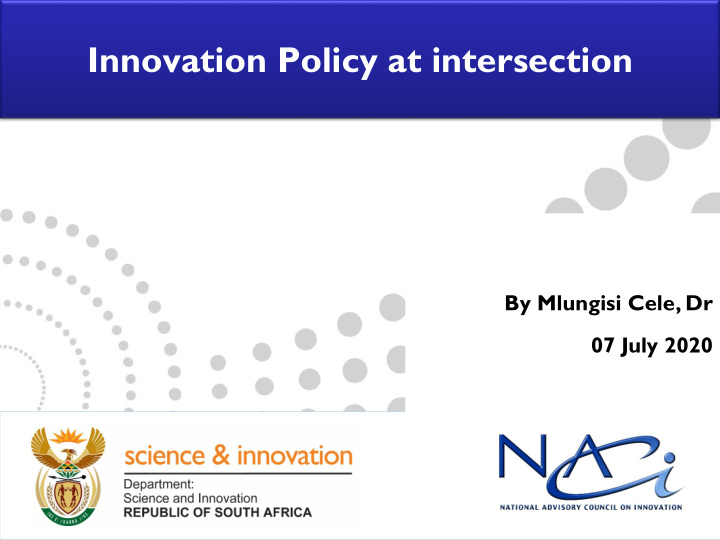



Innovation Policy at intersection By Mlungisi Cele, Dr 07 July 2020 04 December 2019
“Scientific inventions, at all conceivable levels, should enrich human life ...” Chief Albert Luthuli (first African winner of the Nobel Peace Prize), Oslo, December 1961 Cele, Saritas, Sokolov, Greenwood & Letaba 2
…thinking approach Deepening understanding of evolution of innovation policy (or science technology and innovation policy) including revisiting of NSI concept, changing relationship with society and identifying main policy actors, their roles and evolving tasks; Within a particular conjuncture: - pre-and current Covid-19 pandemic situation; production, ecological and social reproduction crises; black lives matter and gender equality movements across the globe. Opportunity to learn -from abstract to concrete. 3
Sustainable Development Goals
Megatrends Shaping our Future OECD STI Outlook (2016) 5
Growth drivers (dtic, 2019) Growth Drivers 1994 - 2008: • Massive opening up of SA economy with substantial Growth Drivers Economy inherited growth of trade, especially imports. 2008 - 2018: in 1994: • Consumer demand grew as we steered the • Global Financial economy to serve all South Africans. • Emerged from extended Crisis ended recessions. • Emergence of China, leading to ‘commodity super - commodity super- cycle’ and credit extension fueled SA growth of 4 -5% • Highly protected (tariffs, cycle. but at cost of severe erosion of SA consumer base. marketing boards and a • Global economy on a broad range of State • Financial & business services outgrew ‘productive fundamentally controls). sectors’ due to credit extension & house price different growth growth. • Inefficient and anti- trajectory now. competitive, largely • Within business services, subsectors such as • Emergence of serving a consumer security, cleaning and maintenance services grew as ‘economic market of 2-3 million business sought to evade labour regulations by nationalism’. whites. outsourcing and casualising the workforce. • WTO under serious • Pockets of mining & manufacturing benefited e.g. threat, protectionism platinum, iron-ore and coal. Manufacturing sectors under guise of linked to mining such as machinery, basic iron & ‘national security’. steel, industrial chemicals grew. 6
Pre-COVID 19 state of the Nation in 2019 1. The economy has been stuck in a low growth trajectory over the last few years (economic performance lower than NDP target of 5% growth per annum). 2. Structural unemployment (29.1 % in Q1 of 2019) against NDP Target of 6% by 2030 3. High inequality (Gini coefficient of 0.68 even with the social wage) against NDP target of 0.6 by 2030 4. Persistent poverty (population living below the Lower Bound Poverty Line (LBPL) increased from 36.4% in 2011 (18.7 million people) to 40.0% in 2015 (21.9 million people) against NDP Target of zero proportion of households with a monthly income level of R419 (in 2009 prices) by 2030 5. Spatial inequality and injustice has not been addressed 6. Decline in quality and efficiency of social service delivery. 7
How will the MTSF 2019- 2024 be measured? 8
Understanding of STI policy STI policy:- a social process, not a technical process not a panacea for all socials; as a contested terrain of struggle. becoming human-centred, and promoting inclusive and sustainable socioeconomic development. outcome and impact. 9
What’s new or acknowledged? • Tackling societal and environmental challenges • calls for system transformations; • shifts towards “ societal ” demand for innovation; • new forms of governance, co-ordination beyond government, inclusion of new stakeholder groups; • integrated policies, new types of programmes; • infrastructural requirements. • Disruptive technology developments with – very likely – pervasive impact on all economies (Next Production Revolution, Digitalisation, AI, Big data etc.); and • COVID-19- significance of STI evidence in policy making. 10
Challenges • Limited demonstration of economic and social return on STI investment; • Lack of robust systematic and systemic policy reviews; • Long-term planning and prioritisation; • Coordination and silo mentality within and across various systems. 11
Our hope • Contributions offer an opportunity to learn on how to improve design and implementation of STI to benefit society. BUT • Why are we where we are? 12
Ngiyabonga Obrigado Спасибо धन्रवाद 谢谢 Thank you mlungisi.cele@dst.gov.za 13
Recommend
More recommend